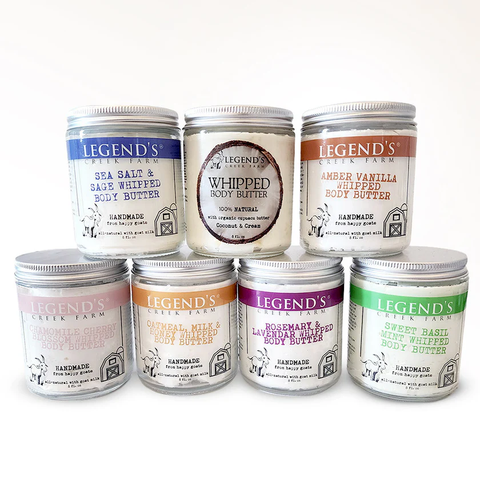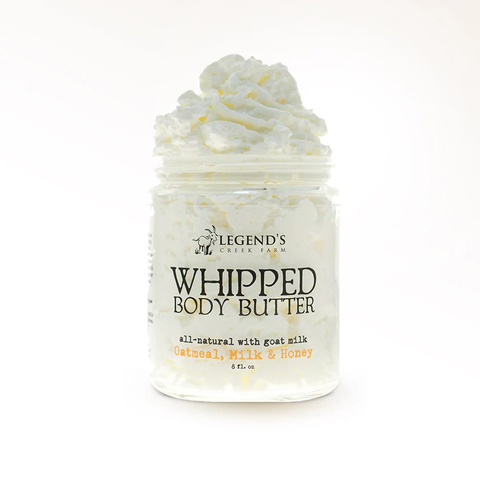Eczema is more than just dry skin, it’s a chronic inflammatory condition marked by a compromised skin barrier, persistent itch, and visible irritation.
For those of us navigating flare-ups, especially on delicate areas like the legs or hands, the search for effective relief can feel endless. Body butters have gained traction as a natural solution, prized for their ability to deliver rich emollients and lasting hydration.
But if you've cycled through a parade of products that promised healing and delivered little more than greasy residue or temporary softness, your hesitation is justified.
Why Eczema-Prone Skin Needs More Than Just Moisture
At its core, eczema reflects a failure in the skin’s protective barrier. This barrier, normally responsible for keeping moisture in and irritants out, becomes porous, leading to rapid water loss and increased sensitivity to environmental triggers.
That’s why simply applying any moisturizer isn’t enough.
If the product can’t restore barrier function and lock in hydration, the cycle of dryness and inflammation continues.
Many off-the-shelf lotions promise quick relief but contain ingredients that undermine long-term healing.
To manage eczema effectively, skin care needs to do three things: deliver deep hydration, seal it in with an occlusive layer, and reduce inflammation.
This is where body butter, when properly formulated, becomes especially effective. Unlike water-based lotions, body butters are rich in emollients that mimic and replenish the skin’s natural lipid barrier.
What Makes a Body Butter Formulation Good for Eczema?
When choosing a body butter for eczema-prone skin, it’s not enough to look for something that feels rich or smells pleasant.
The effectiveness of a product comes down to its formulation, specifically, whether it includes ingredients that support barrier repair, minimize inflammation, and avoid sensitizers.
Ingredients That Work
Certain ingredients consistently perform well for skin in a reactive state.
-
Shea butter, for example, is a cornerstone because of its high content of fatty acids and natural antioxidants that calm inflammation and nourish deeply.
-
Goat milk brings lactic acid for gentle exfoliation and proteins that help rebuild the skin barrier. Colloidal oatmeal is backed by dermatological research for its itch-relieving and anti-inflammatory benefits.
-
And jojoba oil, which mimics the skin’s own sebum, absorbs quickly without clogging pores.
Equally important is what to leave out.
Fragrances, even if they’re essential oils, can trigger flare-ups. Alcohols dry out already-compromised skin, and synthetic preservatives and emulsifiers often add unnecessary stress to the skin’s immune response.
At Legend’s Creek Farm, we formulate body butters using only functional ingredients, raw shea butter, organic goat milk, grapeseed oil, and nothing else that doesn’t serve a therapeutic purpose.
There are no synthetic stabilizers, and the texture is achieved through mechanical whipping rather than chemical thickeners.
Scented vs. Unscented, Is Fragrance-Free Always Safer?
The word “unscented” can be misleading.
Some products labeled this way still contain masking agents that neutralize odor but can irritate sensitive skin. For people managing eczema, even essential oils, though natural, may be too active on inflamed areas.
The safest approach is simplicity: minimal ingredients, no added scent, and full transparency.
Our unscented whipped body butter is crafted specifically with that in mind, no misleading labels, no irritants, just skin-first formulation that prioritizes recovery over aroma.
Lessons from Practice
When managing eczema, it’s not just about what products you use, but how and when you use them.
Some of the most frustrating flare-ups happen during everyday routines that shouldn’t be painful, like shaving or trying to sleep through the night without scratching yourself raw.
That’s where thoughtful ingredient pairing and time-tested application strategies start to matter.
Post-Shave Eczema and Body Butter Use
Shaving can be brutal on eczema-prone legs.
Even when using a gentle razor, the process removes more than hair, it strips the skin’s surface and can trigger stinging, redness, or bumps, especially if eczema is already active.
One of the most common complaints I hear from customers is about the burn they experience when applying lotions post-shave, even ones marketed for sensitive skin.
That’s where raw shea butter and jojoba oil become a game-changer. When applied to freshly shaved skin, this combo mimics the skin’s own lipids, reduces post-shave inflammation, and absorbs without the sting.
The shea butter delivers occlusion and anti-inflammatory benefits, while jojoba supports immediate comfort with its lightweight, non-comedogenic texture.
It’s the kind of pairing that doesn’t just avoid irritation, it actively promotes healing after a task that used to cause a setback.
The Overnight Miracle of Oatmeal & Goat Milk Butters
Nighttime is when eczema symptoms often worsen. Skin loses moisture as we sleep, and the itching can be intense enough to disrupt rest.
This is where a deeply hydrating, calming butter makes the biggest difference.
Our Oatmeal, Milk & Honey Whipped Body Butter is designed to address this exact issue.
With colloidal oatmeal to soothe, and goat milk to gently exfoliate and condition the skin, it works as a two-in-one treatment.
Customers often report waking up to softer skin, less flaking, and fewer scratch marks, small wins that make a big impact when you're managing eczema daily.
How to Use Body Butter for Maximum Eczema Relief
For eczema-prone skin, proper technique helps maximize hydration, reinforce the skin barrier, and extend relief between flare-ups.
Small changes in routine often lead to noticeable improvements.
Proven Methods for Application
The best time to apply body butter is immediately after a shower or bath, while your skin is still slightly damp.
Don’t towel off completely, just pat dry until there’s no dripping, then seal in that remaining moisture by massaging in a generous layer of body butter. This creates an occlusive barrier that keeps hydration where it belongs.
For even deeper results, consider layering: apply a lightweight oil first, like cocoa butter oil or jojoba oil, and then follow with body butter to lock it all in.
This dual-step approach gives the skin both quick absorption and long-lasting protection, a strategy many people find more effective than using either product alone.
If you’re wondering how often to reapply, most people benefit from using body butter every 6 to 8 hours, or whenever they notice skin tightness or increased itching.
During flare-ups, frequency matters more than quantity.
Consistency is Key (And Texture Matters)
One concern we hear often is about texture changes, especially during warmer months when body butter can melt in transit. When that happens, the butter may lose its whipped appearance and feel firmer or oily.
Rest assured, the integrity of the ingredients remains intact.
We never use synthetic stabilizers to prevent melting. Instead, we focus on clean ingredients and honest care. If your jar arrives softened, you can easily re-whip it: melt it gently, cool until semi-solid, then whip with a hand mixer.
The result? That same light, fluffy texture, restored and ready to nourish your skin again.
Common Mistakes to Avoid with Body Butters for Eczema
When it comes to managing eczema, even the most well-intentioned routines can go sideways if key details are overlooked.
First, avoid using scented varieties on open or flaring skin, no matter how “natural” the fragrance sounds.
Essential oils, botanical extracts, and even mild perfumes can act as irritants when your skin barrier is compromised.
On damaged skin, those additives can sting or worsen inflammation rather than soothe it.
Second, be patient.
Eczema is a chronic condition, and no product, even the most thoughtfully formulated body butter, will erase symptoms instantly.
Relief often comes gradually, with consistent use, especially when you're rebuilding the skin’s moisture barrier and reducing inflammation over time.
Lastly, always patch test, even with unscented, ingredient-pure formulations.
Just because a product is free of harsh additives doesn’t mean it’s universally safe. A small test spot on the inner arm can help identify rare sensitivities before applying a product more broadly.
The goal isn’t perfection, it’s progress. With the right body butter and smart application, your skin can become stronger, calmer, and less reactive over time.
Long-Term Results or Temporary Relief? What to Expect
When using body butter for eczema, results can vary depending on the formula, your skin’s condition, and how consistently you use it, but patterns do emerge.
In the short term, many users report noticeable improvements in moisture retention, reduced flaking, and a calmer itch response within hours of application.
Especially when used after bathing, high-fat emollients like shea butter and goat milk help seal in hydration and soothe irritated skin almost immediately.
Over time, the benefits often deepen.
With regular use, typically 2–3 times a day, users begin to see fewer flare-ups, less redness, and longer intervals between reapplications. That’s because a well-formulated body butter doesn’t just mask symptoms; it actively contributes to barrier repair.
Ingredients like lactic acid from goat milk and colloidal oatmeal support cellular turnover and barrier regeneration, making the skin less reactive with each week of consistent care.
We've heard from customers who started reapplying every few hours during flare-ups but eventually found themselves needing it just once or twice daily.
Which Body Butter Will Work for You?
Choosing the right body butter for eczema depends on your skin’s unique sensitivities, the severity of your condition, and your personal preferences around texture and scent.
Some people prefer a whipped consistency that absorbs quickly and feels light on the skin, while others lean toward firmer butters for their denser, longer-lasting occlusion. Both can be effective, what matters is how your skin responds.
If you’re managing moderate to severe eczema, unscented or goat milk-based options are typically safest. Goat milk contains natural lactic acid and skin-conditioning proteins, making it a powerful addition for barrier repair and hydration.
For those with multiple sensitivities or reactive skin, skip essential oils entirely and go for a simple, nutrient-rich formula.
On the other hand, if your eczema is mild and your skin tolerates light fragrance, Legend’s Creek Farm’s Sea Salt & Sage Whipped Body Butter offers a balanced option.
It’s scented just enough to be refreshing, but still gentle enough for compromised skin, thanks to its base of organic shea butter, grapeseed oil, and goat milk.
Should You Add Body Butter to Your Toolbox?
Ingredients like raw shea butter, goat milk, and colloidal oatmeal aren’t cosmetic buzzwords; they’re evidence-backed components that hydrate, soothe, and help rebuild the skin barrier over time.
If you're exploring body butter for the first time, or giving it another try after past disappointment, start with a patch test, stay consistent, and give your skin a few weeks to respond. Healing isn’t overnight, but it is possible.
At Legend’s Creek Farm, we’ve seen the difference a clean, transparent formula can make.
Try our gentle, goat-milk-infused body butters crafted for sensitive skin, designed to calm, hydrate, and protect.
→ Shop Body Butters for Eczema Relief at Legend’s Creek Farm





